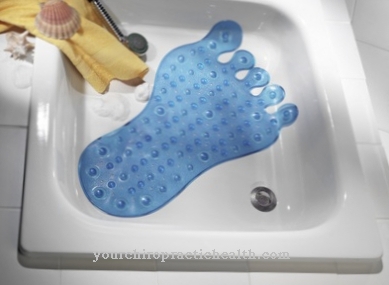Under a Stabilization tape a tape bandage is understood. It is an adhesive bandage that is used to immobilize and stabilize muscles and joints.
What is a stabilization tape?

The stabilization tape is one of the functional bandages. This means that the treated joint is not completely immobilized, as is the case with a plaster cast, but certain movements are still possible with it.
The term tape comes from English and means tape. What is meant is a plaster tape. It is used in sports medicine, orthopedics and trauma surgery. It can be used both for therapeutic purposes and for prevention.
The function of the stabilization tape is based on avoiding undesirable or harmful movements. The plaster strips, which are stable on the skin, transfer the forces that are applied to the skin. This can u. a. provide stable support for the joint capsular ligament. At the same time, the perception of body movements improves. In addition, injured bones or joints are attached to uninjured body structures and swelling is avoided.
A stabilization tape is usually used on the arms and legs. The tape is primarily suitable for the external stabilization of a joint.
Shapes, types & types
A distinction is made between different types of stabilization tapes. These are primarily the classic white tape and the colorful kinesio tape. The white tape is used to stabilize torn ligaments or to fix joints. It is made up of adhesive, inelastic bandages and is mainly used by competitive athletes.
The so-called kinesio tapes, on the other hand, are elastic and are increasingly appreciated by amateur athletes. They are made of a special cotton fabric and resemble human skin in terms of elasticity and thickness. The function of the Kinesio tapes is based on stimulating the skin receptors. When the tape is stuck on, an effect similar to a massage occurs. By removing fluid, inflammation can subside more quickly. Since the muscles relax again, the patient has more mobility. The muscles are stabilized by the elastic tapes without restricting mobility.
There are also other types of tape. These include Kinematic-Tapes, Chiro-Tapes, Medi-Tapes, K-Active-Tapes, Pino-Tapes and K-Taping.
Structure & functionality
Self-adhesive, inelastic plaster strips are used to apply a tape bandage. In addition, however, the use of other bandages is also possible.
A stabilization tape u. a. from anchor strips. These increase the strength of the dressing and make it easier to put on. Further components are the tape reins and the cladding strips. The tape reins emulate the course of the body tape and are held in place by fixing strips. Tightening is also possible. The cladding strips are used to close the stabilization tape and give it additional strength.
A tape dressing may only be applied to skin without irritation. Small wounds can, however, be covered with an appropriate wound dressing.
In order for the material of the stabilization tape to adhere sufficiently to the skin, it must be carefully cleaned. Liquids such as oil, grease or sweat as well as solids (such as dirt or powder) can negatively affect the adhesion of the tape.
In order to properly apply a tape dressing, a course with a physiotherapist should be attended. But there is also relevant literature on this topic. The tape can either be placed around a joint or along the course of a muscle.
The stabilization tape has the advantage over other bandages that the user can also shower with it. In addition, the tape lasts for about a week.
Medical & health benefits
A stabilization tape or tape dressing is said to have various positive effects on health. It supports the treated joint, what doctors call augmentation, serves to immobilize and counteracts swelling. It also ensures improved body awareness.
Its most common areas of application include excessive strain on muscles and joints, strains, sprains or tendinitis (tendovaginitis). In addition, the stabilization tape can be used as part of sports training to prevent sore muscles. Furthermore, it serves to protect against injuries in the event of signs of wear and tear.
The tapes are also suitable for stabilizing ligament injuries or certain bone fractures such as unshifted metatarsal fractures or broken toes. To fix a broken toe, it is fixed to an adjacent toe using the adhesive tape. There is a significant reduction in mobility in the direction of the middle, base and end joints. If the metatarsal bone is broken, the broken bone is stabilized by the four metatarsal bones that have remained uninjured. Good adhesion of the tape is important in order to counteract shifting.
To avoid sports injuries, stabilization tapes are also used preventively in various competitive sports. These include, for example, basketball, handball, surfing, taekwondo and sport climbing. Since the tapes are put on very tightly in sports, they must be removed quickly after the competition.

























.jpg)


